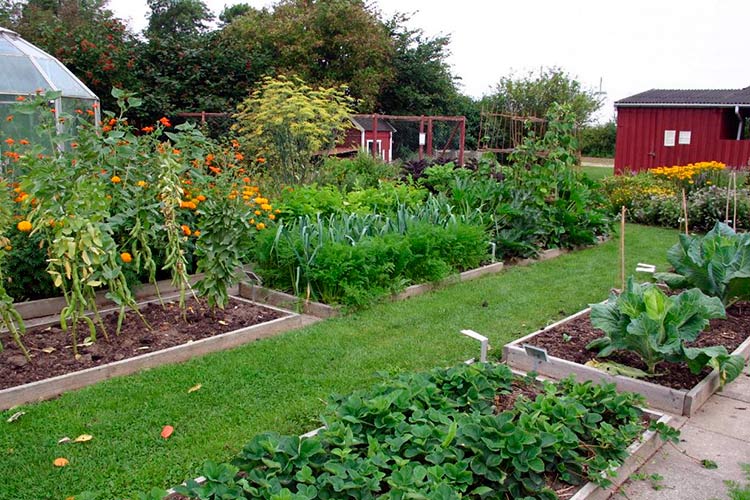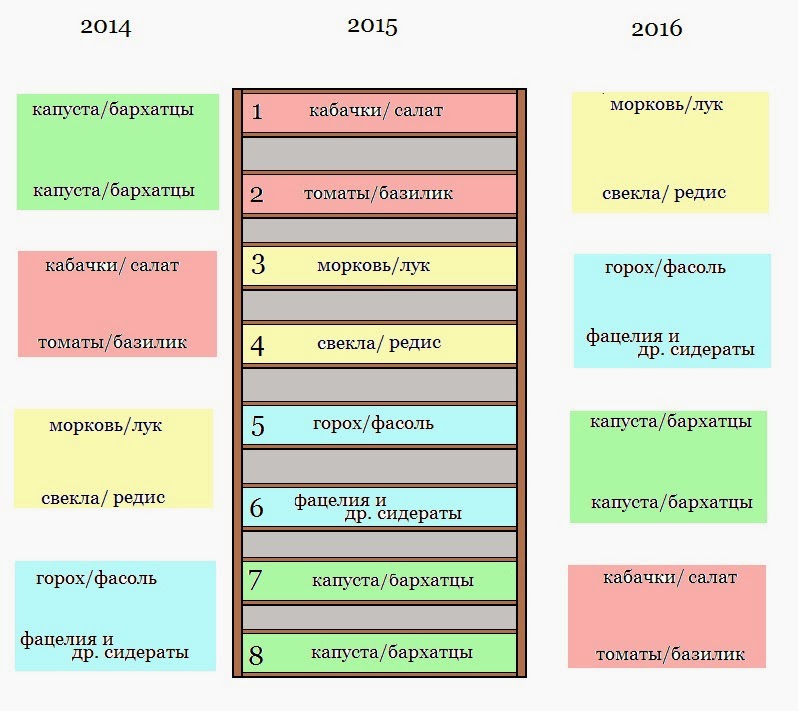Crop rotation table of vegetable crops in the garden: what to plant after which
Content
What it is
The optimally selected alternation of vegetable crops from year to year and their correct placement on the site next to each other is called the crop rotation of vegetables. Annual plants that occupied the garden last year largely determine the harvest this year, it depends on them which plants should be planted and which should not be in any case. For example, it is recommended to grow potatoes after cucumbers and cabbage, it is possible even after beets and carrots, but after tomatoes, peppers, eggplants, they are strictly prohibited.
Tomatoes should be planted after cucumbers, carrots, cauliflower, and certainly not after potatoes. Plants belonging to the same family can be grown in the same place at least after 3-4 years, some experts insist: the period should be 5 years. Therefore, crop rotation is planned for several years at once, and it is necessary to take into account not only the plants that grew there, but also the fertilization of the soil, as well as the crops that will grow nearby.
It is necessary to take into account the influence that vegetables have on each other. So carrots will not grow well next to cabbage - cabbage roots secrete substances that inhibit the growth of carrots, but these substances are probably used for tomatoes. Having a small vegetable garden, it is difficult to adhere to such a strict periodicity, and even if most of it is allocated for potatoes from year to year. Therefore, vegetable growers are trying, by combining all the conditions, to draw up their own crop rotation plan, at least partially close to the ideal. Is it really that important?
Why is crop rotation important?
In order to grow and bear fruit successfully, different vegetables metabolize different micronutrients. So carrots, beets, potatoes need phosphorus in large quantities, but cabbage and all types of salad need nitrogen. Root crops reach the lower soil layers, extracting phosphorus and potassium, and leafy greens with their short roots will not reach there, it feeds in the upper layers. Tomato roots collect food at a depth of almost one meter, and corn roots reach 2 m in height.
If you plant a plot with the same crops from year to year, they will deplete one layer of soil, which means that in a year or two the gardener will not see a good harvest on his plot. In addition, many plant residues remain in the ground, pathogens thrive in them, they will happily pounce on plants that they cannot resist. All sorts of pests who have trodden the path to their favorite garden and settled offspring nearby will not leave the plants alone of their own free will. And the weeds will take root so that they cannot be removed. This is what can happen if you plant vegetables in one place all the time. And to prevent this from happening, you need a competent alternation of crops in the garden.
Video "Making a crop rotation yourself"
How to organize
To plan the crop rotation of all kinds of crops in the garden, you need, first of all, to mark out the beds, to make a diagram of the entire site. Write down what grew on which bed, what will grow next year, in a year, in two years. The table may look like this: Or you can do it in a completely different way, divide the garden into 4 parts, think over which crops will need more fertilizers, which ones will need less.
Allocate the first section to zucchini, cucumbers, cabbage, they will need a lot of fertilizers, so you need to add the required amount to the soil. It is enough to add half of this amount of fertilizer to the soil of the second section for the tomatoes, eggplants, onions, and garlic planted there. The third plot should be given to root crops, the soil for them does not need to be fertilized (root crops cannot be planted where the soil was fertilized with manure in the current year, they can be twisted, damaged and bad in taste). Determine the fourth part of the garden for potatoes and apply very little fertilizer to the soil.
And in subsequent years, change these areas in a counterclockwise direction, as shown in the diagram: Such an organization of crop rotation of vegetables is beneficial for its simplicity, and also because it provides protection against diseases and pests, weed control, even economical use of fertilizers. In order to make it easier to draw up a crop rotation scheme for your site, you can first compile (or take from the Internet, tested on someone else's experience) a table of plants that can be grown after each other.
What cultures to combine
Vegetables, like people, influence each other by being around. Some can emit substances that are useful or harmful to neighbors, others can attract or drive away insects, which will also somehow affect neighbors, and still others are so focused on themselves that they can even be planted between unwanted plants. All these complex relationships have to be taken into account when compiling crop rotation tables.
I must say that the correct combination of vegetable crops in the garden cannot replace the process of crop rotation. They complement each other perfectly, not replace.
Lettuce, spinach, radish grow well next to cucumbers. Carrots feel protected next to onions as their scent drives away pests. And dill during flowering attracts lacewings that feed on aphids, which means there will be protection from aphids next to it. It has long been noticed that onions and beets grown next to dill became tastier, parsley improves the taste of tomatoes. If celery and cabbage are planted side by side, the yield of both crops will be higher.
Potatoes get along well with beans, corn, cabbage, and tomatoes, cucumbers, and pumpkin can ruin your harvest. Cucumbers are good next to beans, corn, peas, but bad - with potatoes, parsley, tomatoes. You cannot plant black radish with onions, carrots with cabbage nearby - they have a bad effect on each other, impair the taste and reduce the yield. Cabbage has a bad effect on tomatoes and beans, although it is better from the neighborhood of beans - there is less threat of pests. These are such complex relationships that occur in vegetable beds, but all of them must be taken into account in order to get good harvests on a small garden or summer cottage.
Video "Which cultures are compatible with each other"
If you do not know how to properly rotate crops in your garden, then this video clip was created especially for you.




